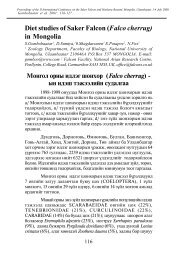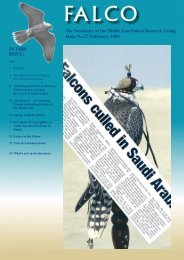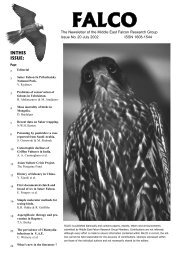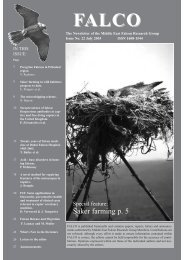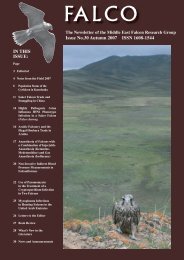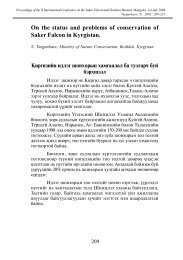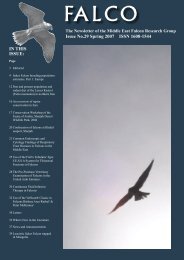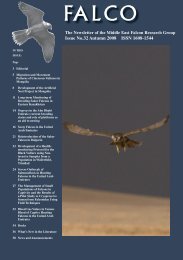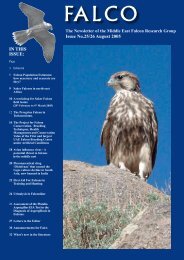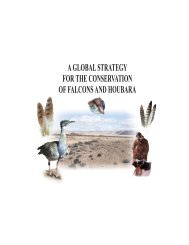Falco cherrug - International Wildlife Consultants Ltd.
Falco cherrug - International Wildlife Consultants Ltd.
Falco cherrug - International Wildlife Consultants Ltd.
Create successful ePaper yourself
Turn your PDF publications into a flip-book with our unique Google optimized e-Paper software.
E. Potapov<br />
Figure 2. The plateau, or Black-lipped Pika (Ochotona curzoniae).<br />
grasses with a lot of un-vegetated surfaces. Amongst other<br />
mammals, we recorded Tibetan Hare, the den of Tibetan Bear,<br />
Argali (Ovis ammon), Blue Sheep (O. pseudois nayaur) and<br />
lot of Wild Ass (Equus kiang). Gazelles (Procarpa picticaudata),<br />
and Kiangs were seen almost everywhere, with occasional<br />
sightings of Tibetan Antelope (Pantholops hodgsonii).<br />
Almost without exception Saker nests were found in<br />
areas with a high density of Pikas, in all cases in the proximity<br />
of the peat-turf covered terrain. In most of the cases the<br />
Sakers used nests originally built by Ravens or Upland<br />
Buzzards. However, in contrast to the populations in<br />
Mongolia and Russia, there is a severe shortage of nesting<br />
material. Almost all our survey area was well above the upper<br />
limit of bush-like vegetation. Hence every item suitable for<br />
nest building was utilized including the bones of livestock, old<br />
cloth, parts of sheepskin and the wool of Yaks, pieces of wood<br />
picked up from roads, old footwear, and even car parts. Saker<br />
nests were placed most commonly on cliffs, followed by artificial<br />
structures such as bridges. The laying date showed<br />
m, asl<br />
6000<br />
extreme variability: we recorded first day of lay on 15 May,<br />
whereas in some nests there were chicks hatching on 14<br />
May. This suggests the span for breeding period as at least<br />
29-32 days. The breeding density in some places is of sufficient<br />
quantity: in a study area of 1811 km 2 we found 5<br />
active Saker nests thus giving the density of 2.3 pairs per<br />
1000 km 2 . Our allocated study area was not far from<br />
Wuolang village, on the road between Golmud and Lhasa.<br />
This is within the Chang Tang Nature Reserve where all animals,<br />
Sakers included, enjoy a high level of protection. The<br />
altitudes of the nest locations of Sakers across Tibet spread<br />
from 3900 m above sea level, with the highest being at 5200<br />
m: this latter being the southern-most located nest of the<br />
Saker known to date – 32 0 58’ N.<br />
It appears that on the Quinhai-Tibet plateau we<br />
have the most elevated population of Sakers in the world.<br />
The nesting habitat can be defined as elevated steppe with<br />
gentle (not more than 45 0 slopes) at an elevation of between<br />
3900 and 5300 m with Carex/Ceratoides and Stipa/Carex<br />
complexes that form turf. This turf structure is important<br />
winter habitat for 9 species of Pikas living in Tibet, with the<br />
Pikas being of prime importance for the Sakers. On the<br />
basis of some primitive GIS calculations, I estimate that the<br />
area occupied by the terrain, within the limits of 3900-5300<br />
m with slopes less than 45 0 , is 1070955 km 2 . (In these calculations<br />
we used Digital Elevation Model, USGS with the<br />
resolution 1km per pixel.) Provided that only a third of the<br />
terrain is covered with the turf-underlain vegetation, and the<br />
estimated density of Sakers in one study area is 2.3 Sakers<br />
per 1000 km 2 of which 2/5 are breeding, the overall figure<br />
of the potential breeding population in the Quinhai-Tibet<br />
plateau is 985 breeding pairs. However this figure needs<br />
verification, as it is based on only one study area. We also<br />
do not have any information on the distribution and biology<br />
of the Saker in the most remote parts of the plateau.<br />
The surveys of 2003 were carried out by the<br />
authors with tremendous help and support from the Institute<br />
Figure 3. The altitude profile of the trip marked on the map in the insert. Light dots indicate Saker nests. On horizontal axis<br />
the odometer given as by GPS, vertical axis altitudes taken from Digital Elevation Map of the Glove, NOAA, National<br />
Geophysical Data Center http://www.ngdc.noaa.gov/seg/topo/globeget.shtml<br />
5000<br />
Pass across Kun-Lun<br />
4000<br />
Quinhai-Tibetan Plateau<br />
3000<br />
2000<br />
Golmud<br />
Quaidam Depression<br />
Lhasa<br />
1000<br />
Edges of Takla-Makan Desert<br />
11<br />
0<br />
0 500 1,000 1,500<br />
Km



